tow Oldsmobile Aurora 1998 Owner's Manuals
[x] Cancel search | Manufacturer: OLDSMOBILE, Model Year: 1998, Model line: Aurora, Model: Oldsmobile Aurora 1998Pages: 380, PDF Size: 19.75 MB
Page 14 of 380
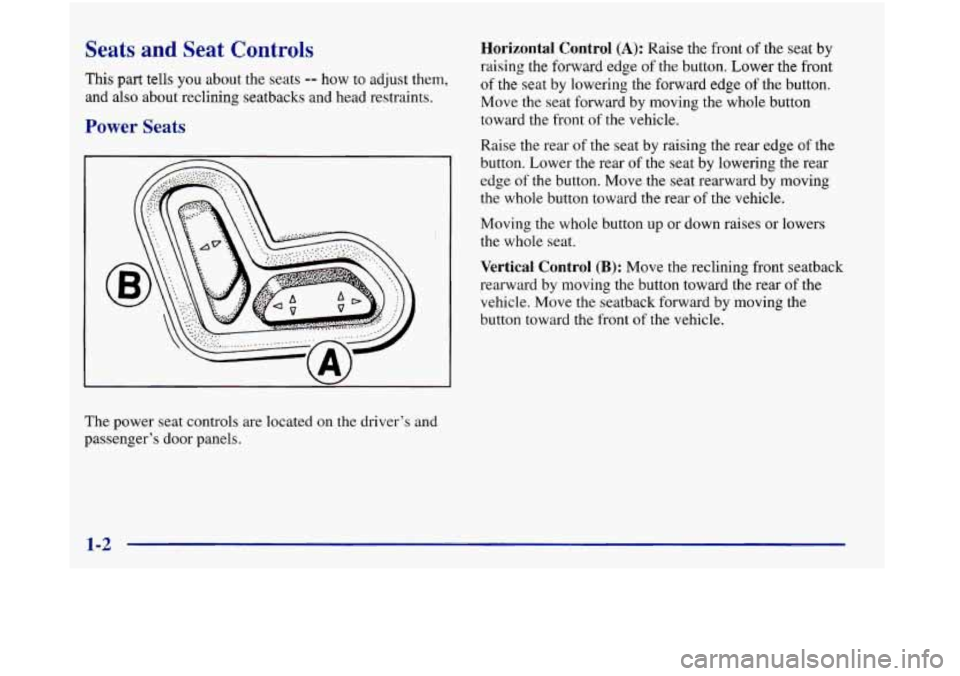
Seats and Seat Controls
This part tells you about the seats -- how to adjust them,
and also about reclining seatbacks and head restraints.
Power Seats
The power seat controls are located on the driver’s and
passenger’s door panels.
Horizontal Control (A): Raise the front of the seat by
raising the forward edge of the button. Lower the front
of the seat by lowering the forward edge of the button.
Move the seat forward by moving the whole button
toward the front of the vehicle.
Raise the rear
of the seat by raising the rear edge of the
button. Lower the rear
of the seat by lowering the rear
edge of the button. Move the seat rearward by moving
the whole button toward the rear
of the vehicle.
Moving the whole button
up or down raises or lowers
the whole seat.
Vertical Control (B): Move the reclining front seatback
rearward by moving
the button toward the rear of the
vehicle. Move the seatback forward by moving the
button toward the front of the vehicle.
1-2
Page 36 of 380

If something is between an occupant and an air
bag, the bag might not inflate properly or it
might force the object into that person. The path
of an inflating air bag must be kept clear. Don’t
put anything between an occupant and an air
bag, and don’t attach or put anything on the
steering wheel hub or on or near any other air
bag covering.
When should an air bag inflate?
An air bag is designed to inflate in a moderate to severe
frontal or near-frontal crash. The air bag will inflate
only
if the impact speed is above the system’s designed
“threshold level.” If your vehicle goes straight into a
wall that doesn’t move or deform, the threshold level
is
about 8 to 11 mph (13 to 18 km/h). The threshold level
can vary, however, with specific vehicle design,
so that
it can be somewhat above or below this range. If your
vehicle strikes something that will move or deform, such
as a parked car, the threshold level will be higher. The
air bag is not designed to inflate
in rollovers, side
impacts or rear impacts, because inflation would not
help the occupant. In
any particular crash,
no one can say whether an air
bag should have inflated simply because of the damage
to
a vehicle or because of what the repair costs were.
Inflation
is determined by the angle of the impact and
how quickly the vehicle slows down
in frontal or
near-frontal impacts.
What makes an air bag inflate?
In an impact of sufficient severity, the air bag sensing
system detects that the vehicle
is in a crash. The sensing
system triggers a release of gas from the inflator, which
inflates the air bag. The inflator, air bag and related
hardware are all part
of the air bag modules inside the
steering wheel and in the instrument panel in front of the
right front passenger.
How does an air bag restrain?
In moderate to severe frontal or near-frontal collisions,
even belted occupants can contact the steering wheel or
the instrument panel. Air bags supplement the protection
provided by safety belts.
Air bags distribute the force of
the impact more evenly over the occupant’s upper body,
stopping the occupant more gradually. But
air bags would
not help you in many types of collisions, including
rollovers, rear impacts and side impacts, primarily
because an occupant’s motion
is not toward those air
bags.
Air bags should never be regarded as anything
more than a supplement to safety belts, and then only in
moderate to severe frontal or near-frontal collisions.
I
1-24
Page 38 of 380

NOTICE:
If you damage the covering for the driver’s or the
right front passenger’s air bag, the bag may not
work properly. You may have to replace the air
bag module in the steering wheel or both the air
bag module and the instrument panel for the
right front passenger’s air bag.
Do not open or
break the air bag coverings.
Servicing Your Air Bag-Equipped Vehicle
Air bags affect how your vehicle should be serviced.
There are parts of the air bag system in several places
around your vehicle.
You don’t want the system to
inflate while someone is working
on your vehicle.
Your retailer and the Aurora Service Manual have
information about servicing your vehicle and the air
bag system.
To purchase a service manual, see “Service
and Owner Publications” in the Index.
I I I
If your vehicle ever gets into a lot of water -- such as
water up to the carpeting or higher
-- or if water enters
your vehicle and soaks the carpet, the air bag controller
can be soaked and ruined. If this ever happens, and then
you start your vehicle,
the damage could make the air
bags inflate, even if there’s no crash. You would have to
replace
the air bags as well as the sensors and related
parts. If your vehicle
is ever in a flood, or if it’s exposed
to water that soaks the carpet, you can avoid needless
repair costs by turning
off the vehicle immediately.
Don’t let anyone start the vehicle, even to tow it, unless
the battery cables are first disconnected.
I
~ For up to 10 minutes after the ignition key is
~ turned off and the battery is disconnected, an air
bag can still inflate during improper service. You
can be injured if you are close to an air bag when
it inflates. Avoid yellow connectors. They are
probably part
of the air bag system. Be sure to
follow proper service procedures, and make sure
the person performing work for you is qualified
to do
so.
The air bag system does not need regular maintenance.
1-26
Page 49 of 380
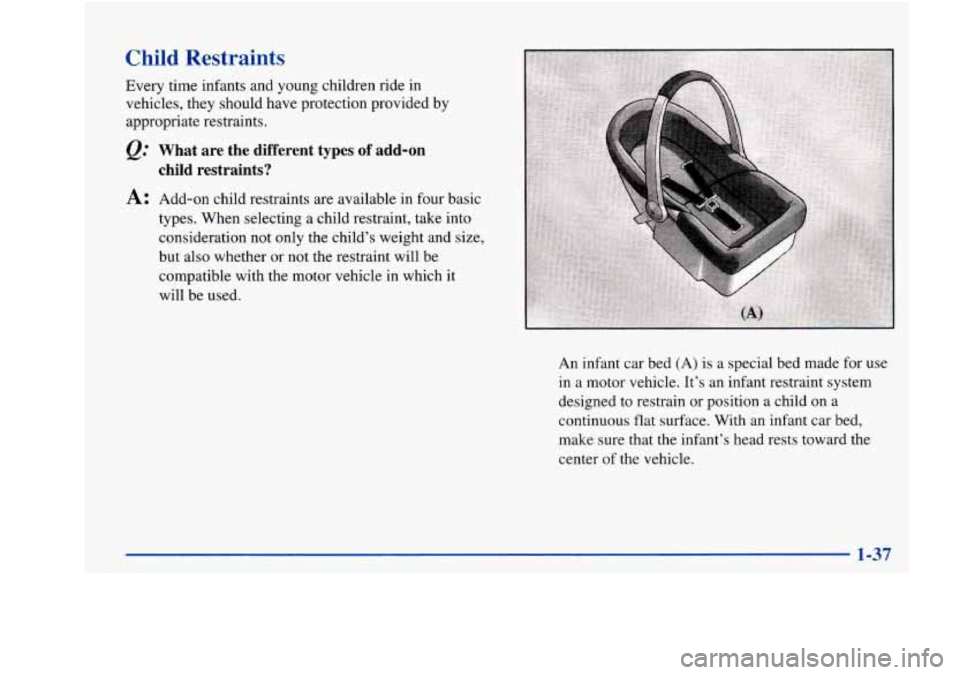
Child Restraints
Every time infants and young children ride in vehicles, they should have protection provided by
appropriate restraints.
@ What are the different types of add-on
child restraints?
A: Add-on child restraints are available in four basic
types. When selecting a child restraint, take into
consideration not only the child’s weight and size,
but also whether or not the restraint will be
compatible with the motor vehicle
in which it
will be used.
An infant car bed (A) is a special bed made for use
in a motor vehicle. It’s an infant restraint system
designed to restrain or position a child
on a
continuous flat surface. With an infant car bed,
make sure that the infant’s head rests toward the
center of the vehicle.
Page 61 of 380
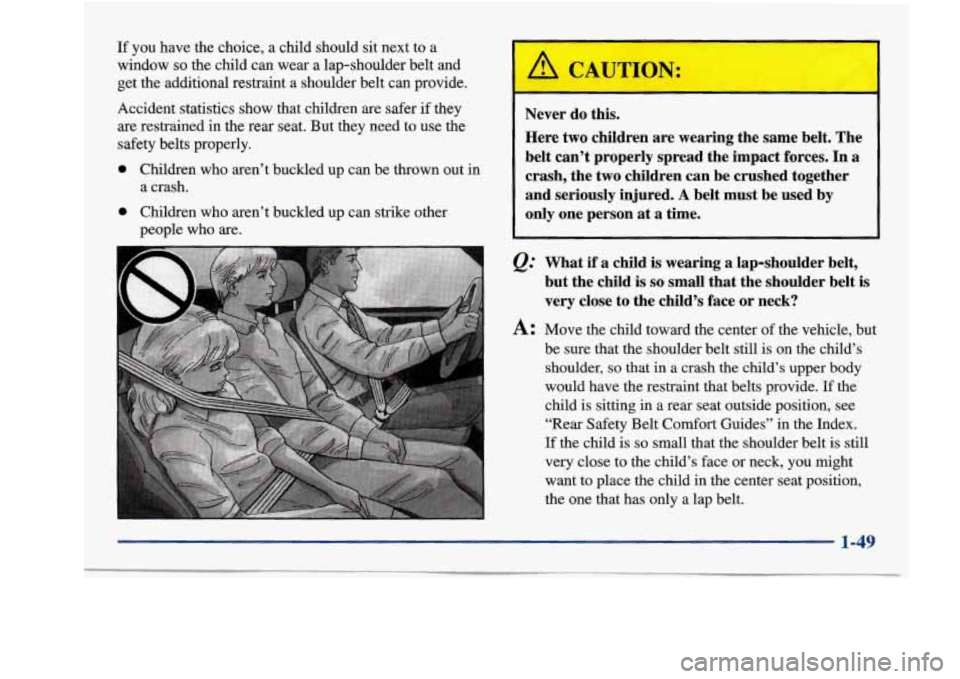
If you have the choice, a child should sit next to a
window
so the child can wear a lap-shoulder belt and
get the additional restraint
a shoulder belt can provide.
Accident statistics show that children
are safer if they
are restrained in the rear seat. But they need to use the
safety belts properly.
0 Children who aren’t buckled up can be thrown out in
0 Children who aren’t buckled up can strike other
a crash.
people who are.
Never do this.
Here two children are wearing the same belt. The
belt can’t properly spread the impact forces. In
a
crash, the two children can be crushed together
and seriously injured.
A belt must be used by
only one person at a time.
&.’ What if a child is wearing a lap-shoulder belt,
but the child is
so small that the shoulder belt is
very close to the child’s face
or neck?
A: Move the child toward the center of the vehicle, but
be sure that the shoulder belt still is on the child’s
shoulder,
so that in a crash the child’s upper body
would have the restraint that belts provide. If the
child is sitting in a rear seat outside position, see
“Rear Safety Belt Comfort Guides” in the Index.
If the child is so small that the shoulder belt is still
very close to the child’s face or neck, you might
want to place the child in the center seat position,
the one that has only a lap belt.
1-49
Page 85 of 380
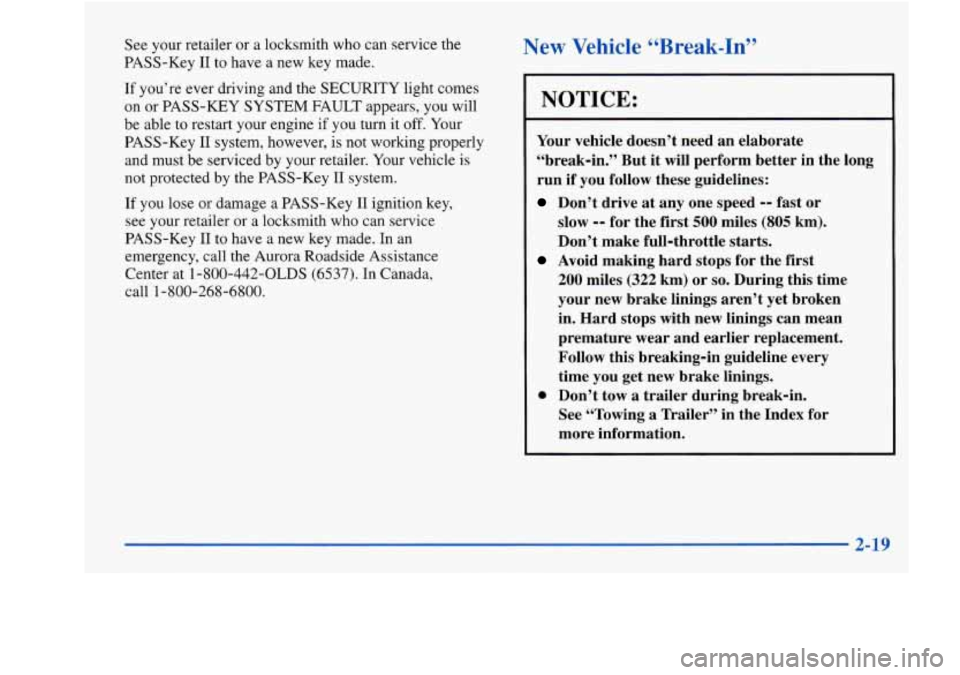
See your retailer or a locksmith who can service the
PASS-Key I1 to have a new key made.
If you’re ever driving and the SECURITY light comes
on or PASS-KEY SYSTEM
FAULT appears, you will
be able
to restart your engine if you turn it off. Your
PASS-Key
I1 system, however, is not working properly
and must be serviced
by your retailer. Your vehicle is
not protected by the PASS-Key I1 system.
If you lose
or damage a PASS-Key I1 ignition key,
see your retailer
or a locksmith who can service
PASS-Key
I1 to have a new key made. In an
emergency, call the Aurora Roadside Assistance
Center at
1-800-442-OLDS (6537). In Canada,
call
1-800-268-6800.
New Vehicle 44Break-In”
NOTICE:
Your vehicle doesn’t need an elaborate
“break-in.” But it will perform better in the long
run if you follow these guidelines:
Don’t drive at any one speed -- fast or
slow
-- for the first 500 miles (805 km).
Don’t make full-throttle starts.
200 miles (322 km) or so. During this time
your new brake linings aren’t yet broken
in. Hard stops with new linings can mean
premature wear and earlier replacement.
Follow this breaking-in guideline every
time you get new brake linings.
Don’t tow
a trailer during break-in.
See “Towing
a Trailer” in the Index for
more information.
Avoid making hard stops for the first
2-19
Page 86 of 380
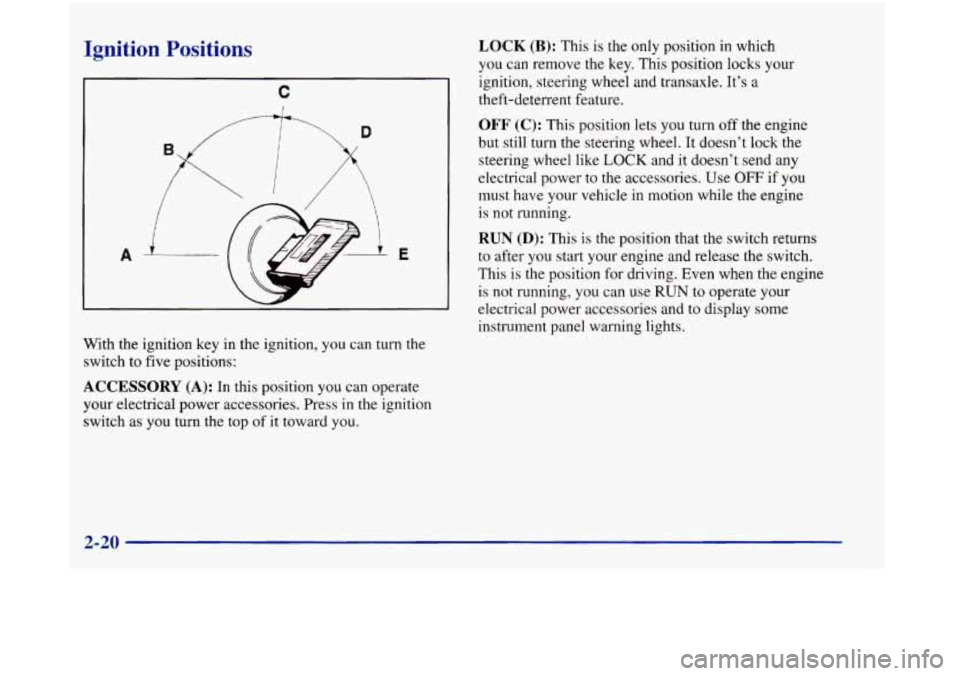
Ignition Positions
C
I
A E
With the ignition key in the ignition, you can turn the
switch to five positions:
ACCESSORY (A): In this position you can operate
your electrical power accessories. Press in the ignition
switch as you turn the top
of it toward you.
LOCK (B): This is the only position in which
you can remove the
key. This position locks your
ignition, steering wheel and transaxle. It’s a
theft-deterrent feature.
OFF (C): This position lets you turn off the engine
but still turn the steering wheel. It doesn’t lock the steering wheel like
LOCK and it doesn’t send any
electrical power
to the accessories. Use OFF if you
must have your vehicle in motion while the engine
is not running.
RUN (D): This is the position that the switch returns
to after you start your engine and release the switch.
This
is the position for driving. Even when the engine
is not running, you can
use RUN to operate your
electrical power accessories and to display some
instrument panel warning lights.
Page 88 of 380
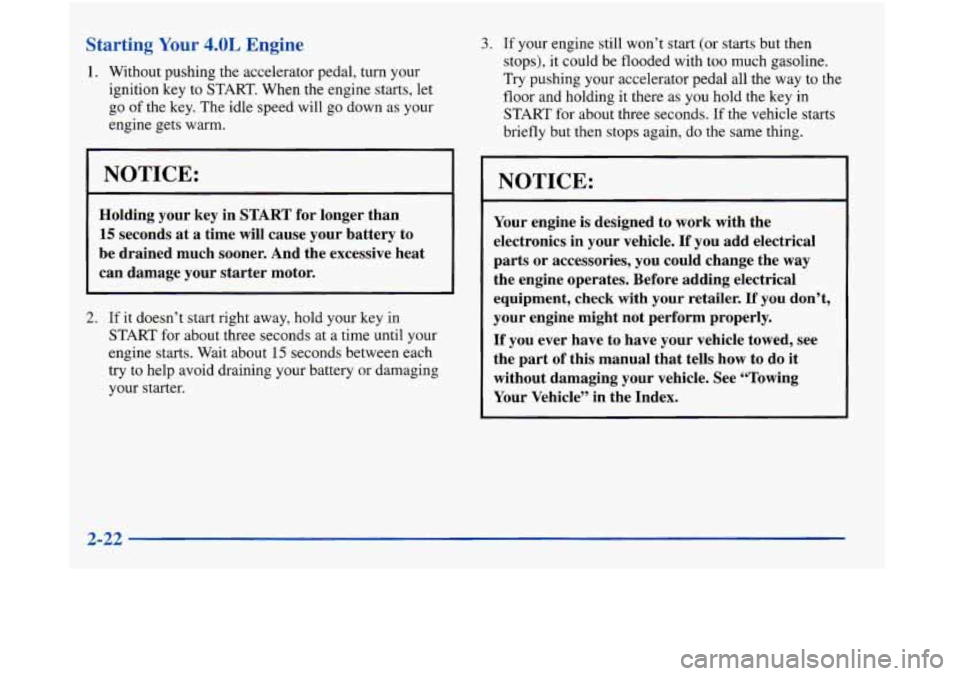
Starting Your 4.0L Engine
1. Without pushing the accelerator pedal, turn your
ignition key to START. When the engine starts, let
go of the key. The idle speed will go down as
your
engine gets warm.
I 1
I NOTICE:
Holding your key in START for longer than
15 seconds at a time will cause your battery to
be drained much sooner. And the excessive heat
can damage
your starter motor. I
2. If it doesn’t start right away, hold your key in
START for about three seconds at a time until your
engine starts. Wait about
15 seconds between each
try to help avoid draining your battery or damaging
your starter.
3. If your engine still won’t start (or starts but then
stops), it could be flooded with too much gasoline.
Try pushing your accelerator pedal all the way to the
floor and holding it there as you hold the key in
START for about three seconds.
If the vehicle starts
briefly but then stops again,
do the same thing.
NOTICE:
Your engine is designed to work with the
electronics in your vehicle.
If you add electrical
parts or accessories,
you could change the way
the engine operates, Before adding electrical
equipment, check with
your retailer. If you don’t,
your engine might not perform properly.
If you ever have to have your vehicle towed, see
the part of this manual that tells how to do it
without damaging your vehicle. See “Towing
Your Vehicle”
in the Index.
2-22
Page 90 of 380
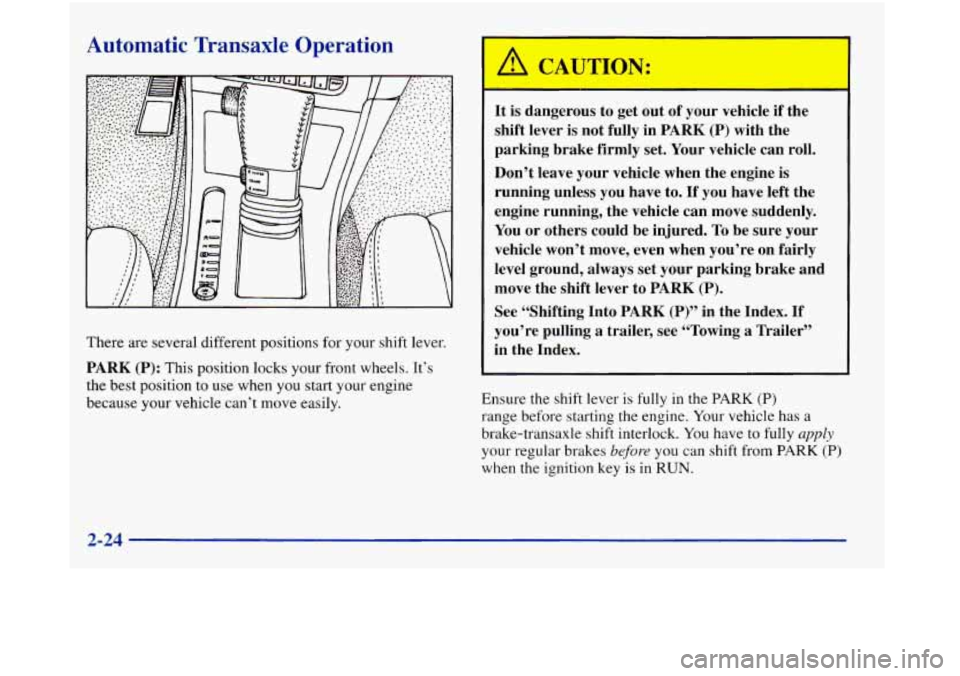
Automatic Transaxle Operation
There are several different positions for your shift lever.
PARK (P): This position locks your front wheels. It’s
the best position
to use when you start your engine
because your vehicle can’t move easily. It
is dangerous to get
out of your vehicle if the
shift lever is not fully in
PARK (P) with the
parking brake firmly set. Your vehicle can roll.
Don’t leave your vehicle when the engine is
running unless you have
to. If you have left the
engine running, the vehicle can move suddenly.
You
or others could be injured. To be sure your
vehicle won’t move, even when you’re on fairly
level ground,
always set your parking brake and
move the shift lever to
PARK (P).
See “Shifting Into PARK (P)” in the Index. If
you’re pulling a trailer, see “Towing a Trailer’’
in the Index.
Ensure the shift lever
is fully in the PARK (P)
range before starting the engine. Your vehicle has a
brake-transaxle shift interlock. You have to fully
apply
your regular brakes bcfore you can shift from PARK (P)
when the ignition key is in RUN.
2-24
Page 91 of 380

REVERSE (R): Use this gear to back up.
I NOTICE:
Shifting to REVERSE (R) while your vehicle is
moving forward could damage your transaxle. Shift to
REVERSE (R) only after your vehicle
is stopped.
To rock your vehicle back and forth to get out of snow,
ice or sand without damaging your transaxle, see
“Stuck: In Sand, Mud, Ice or Snow” in the Index.
NEUTRAL
(N): In this position, your engine doesn’t
connect with the wheels.
To restart when you’re
already moving, use
NEUTRAL (N) only. Also, use
NEUTRAL (N) when your vehicle is being towed. Shifting out
of PARK
(P) or NEU‘l’RAL (N) while
your engine is “racing” (running at high speed) is
dangerous. Unless your foot
is firmly on the
brake pedal, your vehicle could move very rapidly. You could lose control and hit people
or
objects. Don’t shift out of PARK (P) or
NEUTRAL (N) while your engine is racing.
I NOTICE:
Damage to your transaxle caused by shifting out
of PARK (P) or NEUTRAL (N) with the engine
racing isn’t covered by your warranty.
2-25